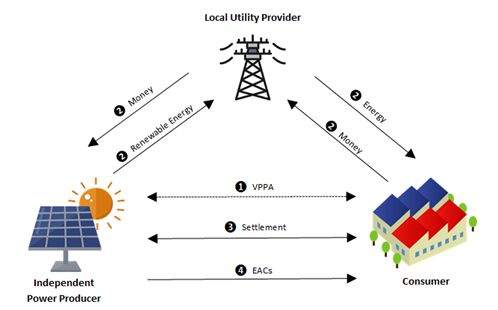- in Asia
- within Privacy topic(s)
On the 29th of August 2022, it was announced by our Prime Minister, Dato' Sri Ismail Sabri Yaakob at the 5th International Sustainable Energy Summit ("ISES") organised by the Sustainable Energy Development Authority ("SEDA"), that Malaysia is expected to bolster its current arsenal of solar energy programmes by introducing the concept of Virtual Power Purchase Agreement ("VPPA"). This is a new procurement option of green electricity supply with a quota of 600MW1.
This article wishes to explore the concept of VPPA generally practiced around the globe and the potential benefits which come with its introduction in Malaysia.
What is VPPA?
To understand how VPPA works, it is helpful to firstly establish how a Power Purchase Agreement ("PPA") works in our current ecosystem. In Malaysia, we are more than familiar with how conventional PPAs operate with it being established in Malaysia since the mid-1990s2. Generally, PPA is an agreement between a solar power producer ("SPP") and Tenaga Nasional Berhad ("TNB") as the distribution licensee for the sale and purchase of electricity generated by the SPP. The electricity produced by the SPP's solar photovoltaic ("solar PV") would be physically transmitted into the local grid (owned by TNB) and such electricity would then be sold by TNB to end users/consumers3.
Furthermore, Net Energy Metering Scheme ("NEM") was introduced in 2016 which allowed consumers to enter into direct PPA with SPPs/investors. Under NEM, investors install and operate solar PVs (which are owned by the investors) on the consumers' premises and the electricity produced can be sold (via a PPA) directly to the consumers at a rate agreed between both parties with excess electricity sold to TNB4.
VPPA on the other hand, also known as Synthetic PPA, differ from the conventional PPA as it does not actually concern the transmission of the physical energy (electrons) produced by the solar PVs. As its name suggests, the supply of electricity is done virtually rather than physically. In other words, consumers continue to receive their electricity from local utility providers and the SPP will continue to sell electricity which they produce to local utility providers5.
The above is possible as VPPA is a financial arrangement between consumer and SPP whereby both parties firstly agree to the price for the virtual supply of electricity ("Strike Price")6. When the market price of electricity is higher than the fixed Strike Price, the SPP pays the consumer the difference between the 2 prices. On the other hand, when the market price of electricity is below the fixed Strike Price, the consumer then pays the SPP the difference between the 2 prices. The difference between the Strike Price and the market price is regarded as the settlement between the SPP and the consumer in the VPPA ("Settlement"). It is due to this mechanism that VPPA is also known as a contract for differences7.
As part of the VPPA arrangement, consumers shall receive Energy Attribute Certificates ("EACs") from the SPPs which certify that the electricity purchased by the consumers was of a green origin. Such certifications are used in jurisdictions which have already implemented VPPA into their energy ecosystem such as United States, United Kingdom and Spain8. In the United States, EACs are known as Renewable Energy Credits9 whereas in the European Market, they are called Guarantees of Origin10. In Malaysia, a similar certification exists in the form of Renewable Energy Certificates ("REC") which is a product of TNBX Sdn. Bhd. (a wholly-owned subsidiary of TNB) and currently available under the Green Electricity Tariff Programme11.
Below is an illustration on how VPPA works:

The Benefits of VPPAs
On the outset, VPPAs look to be an advantageous addition to the solar energy programmes of Malaysia which shall not only bring benefit to the stakeholders of the solar energy market, but also to the environment and the country as a whole. Some of the benefits that come with the introduction of VPPA are as follows:
a) Widen the market for SPPs
VPPA allow SPPs to widen their market by entering into VPPAs with entities existing beyond the proximity of the SPPs. This is achievable due to the nature of VPPAs whereby the electricity produced is not actually transmitted directly to the consumers. Thus, VPPAs open up business opportunities for SPPs which were not available previously12.
b) Consumers are able to meet their sustainability goals
With the proposed introduction of VPPA, it opens up more doors and options for consumers to procure green energy which would be evidenced by the EACs received by consumers. EACs, which are endorsed by credible green energy certification systems (In Malaysia, we follow the International REC Standard as we currently do not have our own proprietary green energy certification system as in certain jurisdictions) allow consumers to use the certification as a basis to report lower carbon emissions which would be in line with global disclosure frameworks on environmental impacts such as CDP and RE10013. VPPA also allow consumers to reduce their carbon footprint and meet their Environmental, Social & Governance ("ESG") commitments which are a growing concern for companies worldwide.
c) Growth of the Renewable Energy Industry in Malaysia
Malaysia still primarily generates its electricity from non-renewable sources as over 80% of electricity generation is fuelled by coal and gas14. This indicates that Malaysia is currently in need of more green energy as the country seeks to depart itself from the unsustainable methods of electricity generation. The introduction of VPPAs would bring in potential investors into the market which would then attract more solar power producers and facilitate new solar projects in Malaysia. Thus, the implementation of VPPAs would definitely help the growth of renewable energy in the country which allows for cleaner and more sustainable forms of energy for Malaysians.
d) No requirement to pay a sleeving fee
Due to the fact that the electricity produced by the SPPs are not physically transmitted to the consumers, consumers are not required to pay a sleeving fee. Sleeving fees are fees generally imposed on the consumers by the grid owner for the transmission of electricity from the SPP's premises (where the solar PV is located) to the consumer's premises by the utilisation of the local grid. The absence of a sleeving fee allows consumers to save on costs which may otherwise be imposed15.
e) Price Hedging
Due to the internal mechanism of VPPAs, consumers and SPPs are able to hedge on the prices of electricity due to the fixed nature of the Strike Price. This financial hedge may afford some stability to both parties especially where markets are constantly fluctuating16.
However, the hedging nature of VPPAs may not be as effective in Malaysia as electricity prices are determined by the Malaysian Government through the Energy Commission ("EC"). The EC adopts a system called the Incentive-Based Regulation ("IBR") which is a regulatory operating model consisting of a Base Tariff, which is a tariff fixed for 3 years and the Imbalance Cost Pass Through ("ICPT"), which is a tariff that is reviewed every 6 months that adjusts itself according to the global fuel (coal and gas) fluctuations17.
Despite the changes to the electricity tariff rates available under the IBR system, due to the frequency in which electricity prices are reviewed, it may seem to indicate that electricity prices in Malaysia are not as volatile as in other jurisdictions, rendering the hedging nature of VPPA to be less effective in Malaysia. Nevertheless, VPPAs could still act as an important tool to hedge electricity prices.
Closing Remarks
Readers should note that the way in which VPPA operate as described under this article is based on how VPPAs are practiced generally in jurisdictions which have already implemented VPPAs. Ultimately, we will have to wait for the publication of the VPPA framework to have a full understanding as to the mechanics of VPPAs in Malaysia.
In recent news, the Government has announced that applications for the 600MW quota will be open starting from 7 November 2022 until 31 December 2022 (or when the quota is fully subscribed to) under the new Corporate Green Power Programme ("CGPP"), kick-starting the use of VPPA in Malaysia. In a statement by the Ministry of Energy and Natural Resources ("KeTSA"), all approved applicants under CGPP must have their power assets operational by 2025. Energy produced by successful subscribers to the quota will sell their energy to TNB under the pre-existing New Enhanced Dispatch Arrangement program18. As part of the evaluation process under CGPP, a special evaluation committee will be set up comprising representatives of KeTSA, EC, and the Single Buyer19.
Applications for the quota will be available at the Single Buyer's website at www.singlebuyer.com.my starting 7 November 2022. The "Panduan Maklumat untuk Program Tenaga Hijau Korporat" which contains further information on CGPP will also be available on 7 November 2022 at the EC's website at www.st.gov.my20.
The introduction of VPPA will undoubtedly benefit Malaysia in both the short term and the long term, increasing access to sustainable energy across the country and provide more opportunities for stakeholders to enter into off-site PPAs (which are still uncommon in Malaysia)21. We must move away from unsustainable practices and follow through with our commitment to reduce carbon emissions by implementing further programmes and laws which can enhance the renewable energy industry in Malaysia.
Footnotes
1. Hailey Chung, Govt set to approve allocation, redistribution of RE quota of 1,200MW for solar resources, PM says, 29 August 2022 https://www.theedgemarkets.com/article/govt-set-approve-allocation-redistribution-re-quota-1200mw-solar-resources-pm-says.
2. Adam Aziz, Tan Choe Choe and Kathy Fong, Cover Story: Power shake-up, 6 December 2018 https://www.theedgemarkets.com/article/cover-story-power-shakeup.
3. Suruhanjaya Tenaga, Guidelines on Large Scale Solar
Photovoltaic Plant for Connection to Electricity Networks, 20
December 2018
https://www.st.gov.my/contents/2019/LSS/Guideline%20on%20LSSPV%20for%20Connection%20to%20Electricity%20Networks_%20
February%202019.PDF.
4. Sustainable Energy Development Authority (SEDA) Malaysia https://www.seda.gov.my/reportal/nem/.
5. Rachit Kansal, Introduction to Virtual Power Purchase Agreement, 2019 https://rmi.org/insight/virtual-power-purchase-agreement/.
6. Enel Green Power https://www.enelgreenpower.com/our-offer/products/virtual-ppa.
7. Kai Imolauer, VPPA – Virtual Power Purchase Agreements – What´s behind it?, 13 February 2020 https://www.roedl.com/insights/renewable-energy/2020-02/vppa-virtual-power-purchase-agreements-renewable-energy.
8. World Business Council for Sustainable Development, Pricing structures for corporate renewable PPAs https://www.wbcsd.org/contentwbc/download/12227/182946/1.
9. Ben Serrurier, Introduction to Renewable Energy Certificates (RECs), 14 May 2020 https://www.leveltenenergy.com/post/intro-renewable-energy-certificates.
10. Max Andrews, Guarantees of Origin: Ensuring 100 per cent renewable power in Europe https://www.statkraft.com/newsroom/news-and-stories/archive/2020/guarantees-of-origin-ensuring-100-per-cent-renewable-power-in-europe/#:~:text=A%20Guarantee%20of%20Origin%20is,renewable%20and%20non%2Drenewable%20electricity.
11. The International REC Standard, Malaysia Launches a Green Electricity Tariff (GET) Program backed by I-REC Standard, 2 December 2021 https://www.irecstandard.org/news/malaysia-launches-a-green-electricity-tariff-get-program-backed-by-i-rec-standard/.
12. Jessica Johnson, 4 Benefits of Using a Virtual Power Purchase Agreement to Acquire Renewable Energy Certificates, 27 May 2020 https://www.leveltenenergy.com/post/virtual-power-purchase-agreement-benefits.
13. The International REC Standard, Malaysia Launches a Green Electricity Tariff (GET) Program backed by I-REC Standard, 2 December 2021 https://www.irecstandard.org/news/malaysia-launches-a-green-electricity-tariff-get-program-backed-by-i-rec-standard/.
14. Mike Thomas, Surging Fuel Costs Rattle the World's Electricity Prices – What Does This Mean for Malaysia?, 2 June 2022 https://www.energywatch.com.my/blog/2022/06/02/surging-fuel-costs-rattle-the-worlds-electricity-prices-what-does-this-mean-for-malaysia/#:~:text=The%20electricity%20prices%20in%20Malaysia,tariff%20reference%20for%203%20years.
15. Kai Imolauer, VPPA – Virtual Power Purchase Agreements – What´s behind it?, 13 February 2020 https://www.roedl.com/insights/renewable-energy/2020-02/vppa-virtual-power-purchase-agreements-renewable-energy.
16. Urban Grid Solar Projects, LLC, Quick Guide To Virtual Power Purchase Agreements, 2 November 2019 https://www.urbangridsolar.com/quick-guide-to-virtual-power-purchase-agreements/.
17. Next Energy Sdn. Bhd., How Malaysia's Electricity Tariff is Determined, 19 June 2019 https://www.nextenergy.my/how-malaysias-electricity-tariff-is-determined/.
18. a program which allows non-PPA/Service Level Agreement (SLA) Generators such as co-generators, renewable energy generators/producers, embedded generators and expired PPA/SLA Generators to operate as Merchant Generators to sell energy to the Single Buyer, TNB.
19. Adam Aziz, Corporate solar PPA quota of 600MW open for applications from Nov 7, 31 October 2022 https://www.theedgemarkets.com/article/corporate-solar-ppa-quota-600mw-open-applications-nov-7.
20. Kementerian Tenaga dan Sumber Asli, Program Tenaga Hijau Korporat sokong Agenda Pembangunan Ekonomi Hijau Negara, 31 October 2022 https://www.st.gov.my/en/contents/files/press/2022-10-31/1667191782.pdf.
21. Sustainable Energy Development Authority and Ministry of Energy and Natural Resources, Malaysian Renewable Energy Roadmap, 30 December 2021 https://www.seda.gov.my/reportal/wp-content/uploads/2021/12/MyRER_webVer-1.pdf.
The content of this article is intended to provide a general guide to the subject matter. Specialist advice should be sought about your specific circumstances.


